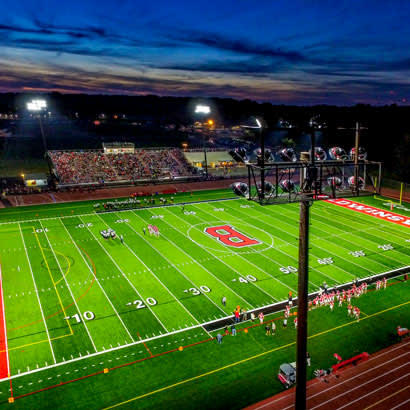
One of the most important innovations for municipalities over the past five years has been the advent of LED sports lighting. A functional product that had not changed for 50 years was revolutionized with unimaginable controllability and functionality. Unfortunately, most people, from operators and architects to electricians and specifiers, were unprepared to understand the differences between high intensity discharge (HID) and LED lighting.
As operators and owners of municipal sports facilities of all sizes consider switching from legacy lighting to energy-efficient and controllable state-of-the-art LED sports lighting, it’s important that they begin the process with a clean slate — an “LEDucation” if you will. Even though LED lights serve the same purpose as legacy lighting products, the technological advances have made old design requirements as antiquated as the metal halide fixtures.
“Very often, we are asked to respond to an RFP that was developed by a third party or even another lighting company that ignores the nuances and advantages solid-state LED lighting has over legacy lighting,” says Mike Lorenz, president of Eaton’s Ephesus Lighting. “It’s important that facility owners and operators learn how to design their lighting requirements to accommodate these new technologies. For example, if you used specs for installing a new phone system that was developed before the advent of wireless telephones, the clause specifying the optimum length of the phone cord would immediately disqualify your wireless solution. Some of the requirements we see in RFPs are just as ridiculous.”
Here are four misconceptions for sports facility design LED lighting requirements:
Remote Not Required
For more than 50 years, sports lighting had been powered by a remote power supply, referred to as a ballast or driver. The belief was that a remote ballast at ground level was more convenient for necessary maintenance, and the added weight of ballasts mounted high on the pole would negatively impact the infrastructure. Those concerns are no longer valid. LED sports lighting is virtually maintenance-free and LED fixtures with a built-in driver are commonplace. Since many operators make the move to LED to help save on energy costs, a remote ballast is counterproductive as extra power is needed to compensate for the distance between the ballast and light source.
LEDucation Lesson #1:
A remote power source/ballast adds operational costs to a solid-state LED lighting system and prevents functionality, such as full dimming ranges and enabling entertainment scenes.
Direct Versus Reflective
Legacy sports lighting products are easily recognizable by the big hoods that help redirect light, via reflection, to the playing surface and control glare. Due to the technological limitations, the hood was an important tool to reflect the light to the playing surface. With digital LED lighting, engineers can now direct the light through internal refractive optics. Whereas reflective lighting redirects the light to the playing surface after it emanates from the fixture, refractive light is precisely modulated internally, to consistently control glare, cutoff and light spill while being delivered directly and efficiently to the playing surface.
LEDucation Lesson #2:
Reflectors limit the efficiency of the fixtures by generating unnecessary light that gets redirected. Well-designed LED lighting solutions can control the light internally and deliver it precisely, with no need for external reflectors.
Maytag Repairman Syndrome
The precision and reliability of LED sports lighting has made 25-year extended warranties as obsolete as the technology they replace. Extended warranties add unnecessary costs since LED technology practically eliminates the need for “routine maintenance.” And, as many consumers have experienced with extended warranties for an automobile or appliance, there are many exclusions that protect the manufacturer more than the customer.
LEDucation Lesson #3:
Be wary of LED sports lighting manufacturers that exaggerate the importance of purchasing an extended warranty.
The Bottom Line
Despite the obvious performance- quality advantages of LED lighting, for most municipalities, the decision is driven by the bottom line, return on investment (ROI) and a cost-benefit analysis. Unfortunately, many facility operators get sticker-shock when they see the initial investment and subsequently don’t do the additional research to understand the numbers. When you combine state grants, power company rebates, reduced maintenance and slashed electrical bills, the initial investment seems less daunting and a fast ROI, especially for indoor facilities that have much greater usage, becomes a reality. Two great resources to help guide you through the process are your lighting salesperson or a third-party energy services company (ESCO).
LEDucation Lesson #4:
Do your research to understand the numerous cost-savings associated with LED sports lighting beyond your electric bill. When you run the numbers, you end up with a much better performing product that eventually pays for itself.
Doug Drotman is a New York-based contributor to Parks and Recreation.

